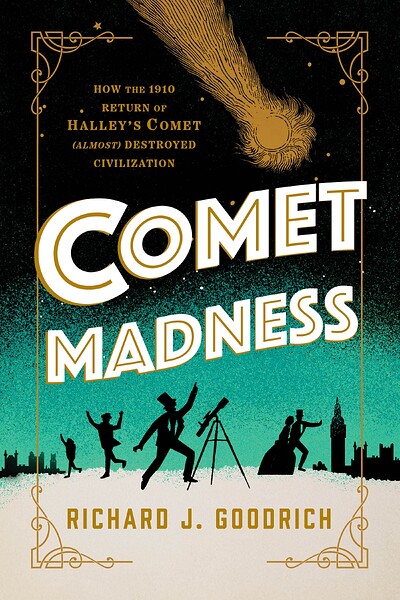Looking for a good read? Here is a recommendation. I have an unusual approach to reviewing books. I review books I feel merit a review. Each review is an opportunity to recommend a book. If I do not think a book is worth reading, I find another book to review. You do not have to agree with everything every author has written (I do not), but the fiction I review is entertaining (and often thought-provoking) and the non-fiction contain ideas worth reading.
Book Review
How Halley’s Comet Reappearance Stirred the World
Reviewed by Mark Lardas
July 2, 2023
“Comet Madness: How the 1910 Return of Halley’s Comet (Almost) Destroyed Civilization,” by Richard J. Goodrich, Prometheus, February 2023, 282 pages, $27.95 (Hardcover), $26.50 (E-book)
For millennia, comets were believed to be harbingers of disaster and change. No one knew what they were. Their terror faded after Edmond Halley proved they were natural phenomena, following laws of physics. He predicted that a comet visible in 1682 would reappear in 1759. It was named Halley’s Comet when his prediction was realized.
“Comet Madness: How the 1910 Return of Halley’s Comet (Almost) Destroyed Civilization,” by Richard J. Goodrich, tells what happened during its 1910 return. It actually proved to be a study of the impact of the mainstream media, an intersection of science and superstition.
Scientists were excited by its return. Goodrich shows that no one completely understood what comets were as the 20th century opened. For astronomers, Halley’s Comet’s predictable return offered an unprecedented opportunity to explore comets’ mysteries.
The general public was equally interested. Their interest was served by the mass-market newspapers that had emerged since the 1835 Halley’s Comet appearance. These were fed by U.S. wire services with international reach. The Associated Press was the CNN of the day.
Unfortunately, the news media’s goal was less focused on dispassionate, balanced coverage than on maximizing sales. Then as now, if it bleeds it leads. The comet’s reappearance was exciting, but not exciting enough. Newspapers used creative editing and storytelling to add excitement.
Statements made by enthusiastic astronomers were selectively edited to become dire predictions. One example: The comet’s tail had cyanogen in it, and Earth was going to pass through the tail. The press ran stories predicting that everyone would die from cyanogen poisoning. While untrue, the press managed to get astronomers to fight each other over the claims, creating more controversy and selling more papers. Wire services invented stories about bizarre panic reactions: people conducting human sacrifices, crucifying themselves, and committing suicide due to fear of the comet.
Mark Twain and King Edward VII of England both died during the comet’s reappearance. Mark Twain even predicted his death. However, both were in failing health. The press blamed the comet, also blaming it for floods and extreme weather.
Yet Goodrich shows there were also real marvels. Astronomers learned much about comets, and millions were thrilled, lying on rooftops to see a wonder of nature. “Comet Madness” captures everything: the scientists and charlatans, the wonders and the fears elicited. Goodrich shows that science is never really settled, only refined over time. He wraps everything in an exciting, informative, and entertaining book.
Mark Lardas, an engineer, freelance writer, historian, and model-maker, lives in League City, TX. His website is marklardas.com. This review appeared in a different form in American Essence magazine and Epoch Times.
